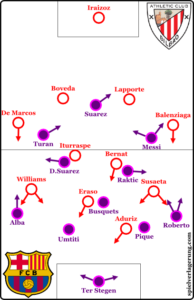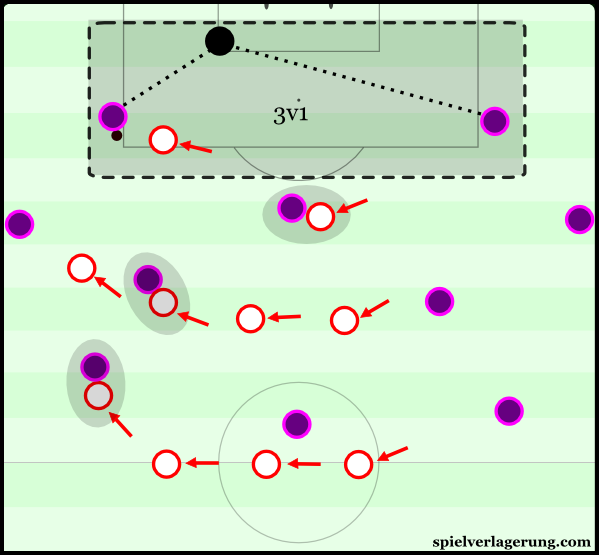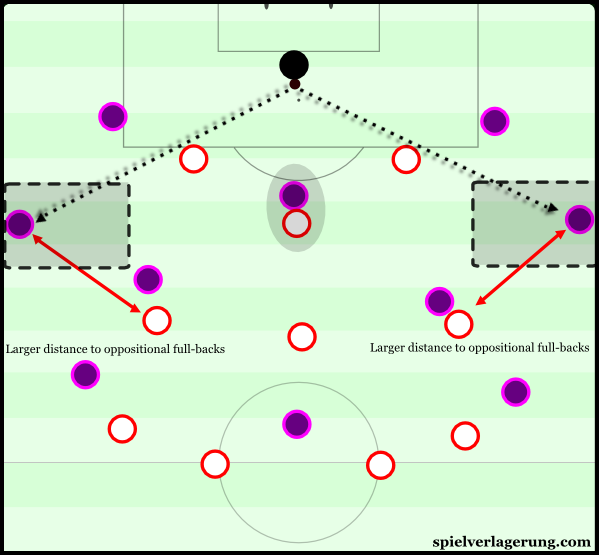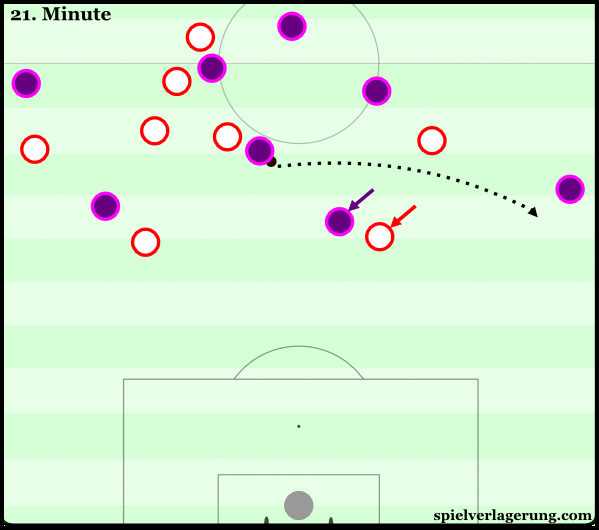Enrique’s men resist Bilbao’s intense pressing
La Liga champions Barcelona made the short trip to the Basque country to take on Athletic Bilbao on Sunday evening. In what is one of the more eagerly anticipated clashes on the La Liga calendar, Bilbao’s intense and energetic pressing was pitched against Barcelona’s commitment to passing out from defence. What followed was a thrilling encounter where only poor finishing from both sides meant the game finished with one goal.
Bilbao’s ball-oriented pressing
Starting from a base 4-2-2-2 shape Bilbao pressed actively during the initial periods of Barcelona’s build-up. When Ter Stegen had the ball the front two held positions on the edge of the box as they tried to make it hard for Barcelona Ter Stegen to distribute to the centre backs.
At times they showed an interesting variation where Aduriz would start from the left half space and curve his pressing run towards Ter Stegen whilst covering the passes into Pique. In these situations Eraso would stay in the centre covering Busquets as they invited the Catalans to build on their left. This was presumably due to Bilbao perceiving Barcelona’s left side to be weaker.
When the ball was played to the flanks Bilbao displayed quick and intense ball-oriented shifting to create access on the flanks. The ball-near winger would sprint out to meet Barcelona’s full-back and the ball-near forward would shift wide to support the press. The ball-far forward would drop diagonally to cover passes into Busquets.
At times they had issues with access due to the lack of presence in the front line which made them vulnerable to switches across Barcelona’s back line. This was particularly problematic due to the enormous energy they expended in shifting across to the flanks. On some situations Barcelona used these switches across the back line to create access to Busquets from the other flank on the occasions the home side could not shift quickly enough.
In many situations they pressed in a 4-3-1-2 where one of the central midfielders would move forwards to situationally mark Busquets and they retained the 2 man presence in the front line. To maintain stability in the centre the wingers would move slightly deeper alongside the other central midfielders. The issue then became that they were more vulnerable to wing-oriented progressions as the wingers had bigger distances to make if they wished to create access to Barcelona’s full-backs.
Generally however Valverde’s men were very successful at forcing Barca away from the centre and guiding them towards the flanks. From here they aimed to regain the ball with sprints from the wide players and situational man-orientations on the near side. However they were only sporadically successful at forcing turnovers on the flanks and this was partly due to…
Barcelona’s 3-3-2-3 and wing-oriented combinations
Yes, you read that correctly. Of course with only 10 outfield players permitted Barcelona’s 3-3-2-3 shape was created through a strong use of their goalkeeper; Marc Andre Ter Stegen. Faced with Bilbao’s intense ball-oriented pressing Barcelona used Ter Stegen to create a numerical advantage which was crucial in stabilising their build-up.

Ter Stegen’s involvement in Barcelona’s passing. Thanks to Barcanumbers
Ter Stegen produced an exemplary performance of goalkeeper distribution, using a range of techniques to bypass pressure. At times he used small dribbles to open passing lanes and his ability to use either foot enhanced his ability to access either side of the field. On other occasions he used chipped passes to reach the centre backs and avoid the cover shadows of Bilbao’s forwards. Perhaps most impressively he moved like an outfield player at times. Ter Stegen was not afraid to vacate his goal to create connections from the flanks back into the centre to help switch to the far side.
With Ter Stegen, the two centre backs and Busquets occupying a position slightly ahead, Barcelona outnumbered Bilbao’s first line of pressure 4v2. This immediately created at least one passing option, allowing Barcelona to make the initial progression from the goal keeper. Another key aspect in this was Sergio Busquets. His influence in these situations demonstrated a huge indirect advantage of possessing individuals of his immense quality.
With the amount of influence Busquets exerts on Barcelona’s build-up (and all phases of the game) on a weekly basis, opponents pay him considerable respect and prepare their approach with him in mind. In this game the position he held on the edge of the box attracted Bilbao’s two forwards to occupy narrower positions in turn creating more space for the centre backs to receive passes from Ter Stegen. Once they received the pass Busquets’ positioning at times attracted the ball-far forward into the centre of the field. Whilst this at times restricted Barcelona’s ability to use Busquets in these situations, it created the space to switch to the far side and escape Bilbao’s ball-near intensity.
For several periods in the game, Busquets was able to direct and influence Barcelona’s build-up massively despite rarely touching the ball.
Although the home side’s compactness and intensity against the ball was successful in forcing Barcelona to build through the flanks, they were able to do so consistently and in a fairly stable fashion. There were a number of factors behind this. Firstly their spacing in these areas was strong and facilitated their collective press resistance. With the wide movements of the 8s, and the positions of the ball-near full-back and winger they created diamond shapes. This gave the ball carrying centre back diagonal passing options to either side and a vertical passing option.
Through their appropriate spacing they had strong connections to facilitate combinations on the flanks. However there was still one issue they needed to get around. With the quick and intense ball-oriented shifting of Valverde’s side these players were rarely free to receive passes. Furthermore the full-backs were subjected to pressure from the Bilbao wingers who would sprint diagonally forwards to engage Alba and Roberto.
Interestingly Barcelona often used this very mechanism to this advantage, this was where the individual press resistance of Alba and particularly Roberto was required. With Bilbao’s wingers sprinting forwards to create access Barcelona’s full-backs often quickly shifted the ball back in the direction they were approaching from. This allowed them to bypass the pressure and create the space to either drive forwards or combine with the nearby team-mates and progress the build-up down the flank.
This was so effective because of the momentum Williams and Susaeta generated in their sprints. With the quick shift of the ball they would have to completely stop and change direction to gain access to the ball again. This would of course take time, and in these intervals Barcelona’s full-backs accelerated forwards to increase their advantage.
On other occasions the Barca full-backs would simply play one-twos upon receiving the ball on the flank and this utilised the same advantage of momentum to bypass Bilbao’s pressure on the wings.
Barcelona’s offensive diagonality
In the final 3rd Barcelona displayed a typically diagonal orientation. They often used dribblers moving infield diagonally. These were combined with diagonal runs in the opposite direction to drag defenders away and open space on the far side. These were highly effective at creating the lanes for the half space switches they used to shift the location of attack around Bilbao’s box.
This is potentially an example of recognisable offensive patterns coming from strong synergy between players. These situations could simply have been a result of the group understanding of the nature of their wide players and how best to make them effective. With Messi and Turan playing on the opposite side to their stronger foot the positions where they could be most effective would be moving infield from the half spaces. The players in the centre therefore used their movement to take defenders away from these areas to give Messi and Turan space to dribble infield diagonally.
Barcelona’s opening goal was a good example of this. With Denis Suarez making two excellent sacrificial diagonal runs he opened the angles for both Luis Suarez’s diagonal through ball to Turan and Turan’s far post cross to Rakitic. Without touching the ball, Denis Suarez was perhaps the key factor in the creation of the winning goal.
Conclusion
In a highly competitive game Barcelona edged victory with Rakitic’s 1st half goal separating the two sides. Despite the score Barcelona were quite dominant and if not for their profligacy they would have had a more comfortable margin of victory.
Whilst Bilbao’s pressing, intensity and compactness was quite impressive they were generally unable to unsettle Barcelona. Barcelona’s press resistance ensured plenty of entries into the final 3rd, as the likes of Messi could take advantage of the space created when the press was beaten.
Bilbao however demonstrated their competence and with some improvements, particularly to their offensive game, will be superior to several sides.






1 Kommentar Alle anzeigen
Matt September 6, 2016 um 4:35 pm
Great anylasis. Re- watched the game and saw how impressive Braca press resistance is. They used it to their advantage to stretch the Bilboa’s compactness by inviting the press which during the game stretched their compactness vertically. This created numerical superiority in between the lines which they exploited, creating several good goal scoring opportunities. This was a fascinating game to watch.